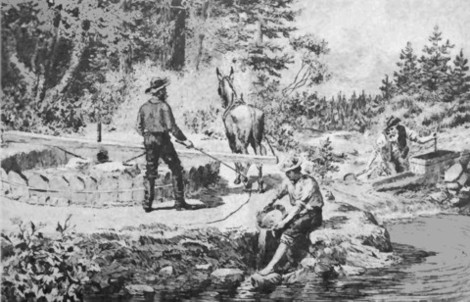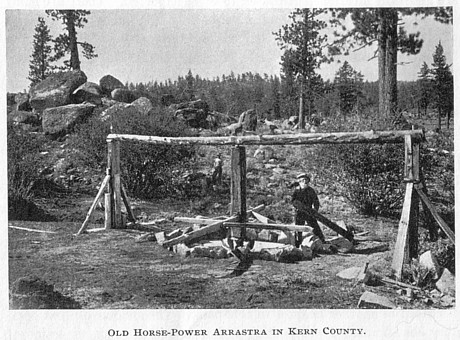4. FACILITIES FOR WORKING. The faculty of locality, which must be well developed in a prospector to enable him to find his way through the wilderness, will usually also enable him to describe the best routes of access to his property and what can be done or has been done in the way of trails and roads. It will also enable him to answer questions as to the supply of timber for mining purposes (a most important item) and for fuel, if coal is not accessible, so that the water supply and the chances for economical development are the only questions to which we need allude in detail under this heading. If fuel is scarce and water abundant, the latter may furnish the motive power if the supply can be used under pressure, either directly or through the use of electricity, and to enable the prospector to readily estimate this power, a short chapter has been devoted to the measurement of water, and the method of calculating the horse power which a given quantity will develop. This depends on the quantity and the fall which can be secured, modified slightly by the distance it has to be taken to secure the fall, so that the prospector should be able to answer these questions approximately. A measurement of the supply taken in the dry season is most desirable as giving the supply which can be depended on all through the year without the use of reservoirs, which are costly and often impracticable.
In not a few mining camps water is scarce during the early stages of development, but while this scarcity may increase the cost of the earlier work, the defect is one that usually remedies itself before any considerable depth has been attained, an abundant supply being generally secured from the shafts and tunnels, even if the quantity does not prove excessive as in Tombstone, Ariz., which in early days was a notoriously dry camp.
The manner in which the vein can be opened to the best advantage will depend on the shape of the country and the way the vein crosses it. If flat, shafts must be resorted to; if hilly, it may be better to adopt tunnels if they can be run on the vein, and the prospector should inform himself thoroughly whether this can be done to advantage, which will depend on the position of the outcrop. This question is more fully treated later on early development, and attention is merely called to it here, as one of the things on which all possible information should be acquired.
5. LESSON OF THE OUTCROP. All the foregoing remarks apply only to the surface observations, but in studying the outcrop we may gain some insight into the probabilities of depth. Present Appearance not the Original The first necessity is to disabuse the mind of the idea that the veins were all formed after the country had assumed very much its present shape and appearance. The remark so commonly made, that a vein which shows poorly on the surface will improve with depth, is based on this fallacy, the underlying idea evidently being, although probably not even thought out in the mind of the speaker, that the ore at that particular spot had not been able to reach the surface, a notion assisted by the other false idea that all the filling of the veins had been squeezed into them from below.
As a matter of fact there has been an immense change in the surface since the majority of the mineral deposits were formed. In the case of coal fields originally laid down horizontally and subsequently tilted to steep angles, whole sections of these fields have been worn away along with the inclosing rocks, or we should have no outcrop of them. In California we have absolute proof that the rocks which carry the gold veins have been worn away in places, even since the eruption of the basalt lavas which filled and covered up the old river channels to a depth of fully 2,000 ft., as in the canons of Slate Creek, Canon Creek and others in Sierra and Plumas counties. As these old river channels carry gold nuggets, in fully as great a quantity as the modern placer streams, which must have been derived from the wear and tear of the hills which formed their flanks, there must have been extensive erosion before the flow of the lava, to carve out these immense valleys, so that we may add an unknown quantity to the known 2,000 ft., and probably be within limits if we estimate the degradation of the mountains carrying the gold veins at 4, 000 ft. or over.
Writers on Abyssinia state that in the approach to Magdala gorges 4,000 ft. deep have been cut down through the basalt into the underlying rocks, leaving the basalt as table lands, much as in California, and if gold veins traversed the rocks of the Grand Canon of the Colorado we should have their secrets exposed 3,000 ft. below the top of the plateau, through which the river has carved its stupendous gorge. It is therefore evident that in the great majority of cases the outcrops of veins may be called purely accidental exposures, which have been constantly changing in their appearance for thousands of years.
Increase or Decrease in Depth. The erosion or wear and tear by air and water may have proceeded just far enough to uncover the top of the ore body, or it may have progressed so far that nearly all of it may have been removed. Are there any evidences in the outcrops themselves as to which stage has been reached? Before entering on this question, however, let us look at the probable increase or decrease in the value of the ore in depth.
In the case of veins which carry large quantities of sulfide bearing ores which are easily decomposed, such as iron pyrite and chalcopyrite, we may expect a decrease in value on reaching the permanent water level of the mine, below which the decomposition will not have extended. If these iron pyrites carry gold, the gold will have been liberated by their decomposition, and will accumulate in the cavities of the rusty quartz; and as the ore after the removal of its sulfur and part of the iron is lighter, bulk for bulk, than the uudecomposed sulfides below, we have a greater bulk to the ton and also an enriched material, so that assays of the croppings are likely to be better than can be had after the water level is reached.
In copper ore veins the decomposition of the chalcopyrite results in the formation of the red and black oxides of copper (just as in the former case the product of decomposition was oxide of iron) both of which are richer in copper per ton than the sulfide; and as they are practically concentrated surface deposits, not extending below the water line, and may result from the decay and leaching of very poor ores, we have another instance in which the vein would be poorer in depth.
But where no decomposition has taken place there is little or no proof of continuous improvement in depth, and more probability of impoverishment of the vein. If the former were the case the improvement ought to be continuous and there would be no limit to the increase of the deposit, which we know not to be the case ; and it is more than likely that the quality of ore varies greatly in nearly all instances, sometimes improving and sometimes growing poorer as the earth is penetrated, being governed very largely by changes in the character of the rocks traversed by the vein, and accidental conditions which we have not yet learned to realize and understand.
But the prospector need be in no doubt on this point, as in most cases he can satisfy himself from personal examination as to the facts. If, as has been stated, the deposits were formed when the country was more elevated than at present, any ravine cutting across a vein or deposit explores it naturally as we do artificially by sinking a shaft, and if improvement follows with increased depth, the outcrop at the bottom of the ravine ought to be richer than one on the summit, as a descent of 100 ft. vertically below the top of the ridge would be equal to the 100 ft. level of a shaft sunk on the outcrop 200 ft. would equal the 200 ft. level, and so on. How little this accords with experience every prospector knows.
Continue on to:
Gold Prospecting Basics, Part 4
Return To:
Gold And Silver Basic Prospecting Methods


